Posted by Marcus Hom on 2022 Mar 24th
270 Winchester and Colorado Elk
I shared this story with a friend and caught a little flak. He asked me what cartridge I used to harvest my elk, and I told him 270. "270 what," he asked? Knowing what a gear junkie I am, he was expecting something new and whiz-bang, maybe a 27 Nosler or 6.8 Western or at least the 270 WSM. "Just the good old Jack O'Connor special, 270 Winchester," I replied. I explained I wanted to have one dedicated hunting rifle with readily available ammo, should I have to buy it off the shelf, that would work on everything from coyotes to elk. The good old 270 Winchester offered me just that with its wide range of bullet weights. He seemed a little perplexed, so we sat down and ran the numbers. With Berger's 170 EOL, I am doing everything the 6.5 PRC is except with more energy on target. Sure, I could squeeze a little more out of a Magnum like the 6.8 Western or the 270 WSM, but that would have required a different bolt face, and do I need the extra 200 Feet Per Second (FPS) and the recoil that comes with it? I think not.
First, a little background, I did not grow up hunting. My teenage years were spent playing sports like rugby and football, which didn't leave much time to go out hiking in the hills during hunting season. I started hunting after moving to Alaska as an adult, and I was fortunate enough to have good mentors and an abundance of game. I still remember harvesting my first Sitka Blacktail with a borrowed 30-06. We went out cruising the road systems of Prince of Wales Island, spotted a few deer, and had one down before evening. With my friends' help, we had the deer processed and packaged before I went to bed that night. Since then, I have been a meat hunter, which is why I put in for a cow elk tag in my current home state of Colorado. With one preference point in the bank, I was not surprised when I drew my tag.
To my wife's displeasure, a new hunt can often warrant a new hunting rifle. I had a Mcmillan stock and a Howa 1500 long action, but what caliber would I choose? I wanted an all-around hunting rifle with enough terminal performance for most North American game and readily available ammunition for those occasions when I don't have time to hand load, or I find myself in a bad situation where I have forgotten or lost my ammo.
30-06 seemed like the most obvious choice, but I couldn't bring myself to shoot those slow, fat low B.C. projectiles. Thirty caliber projectiles don't start to shine until getting over the 200-grain mark, which is too heavy to ask the 30-06 to push. In recent years the 280 and 280 AI have been making a good resurgence into the market. Ammunition can often be found, but not quite as easy as what I eventually chose; additionally, my selection would have better external and terminal ballistics and have a bullet with higher sectional density. Sectional density is a single number derived from the bullets' diameter and mass. It is an excellent number to reference for hunting bullets because a higher sectional density will generally lead to better penetration.
THE BULLET
Ultimately, my choice was driven by a particular projectile. In recent years Berger bullets have been pushing the envelope with heavy high B.C. projectiles. These bullets require a faster than standard twist rate to stabilize them. Still, if a shooter is willing to rebarrel to a faster twist rate, they can mitigate the effects of wind and hit harder on target than almost anything else fired from the same cartridge. In my case, the 170-grain Extreme Outer Limits (EOL) projectile got my attention. It has a G1 B.C. around .670, and after looking at some load data, it appeared a .270 Winchester would be able to push this 170gr pill somewhere between 2800 and 2900 feet per second. This would put me in the neighborhood of 7mm Remington Magnum energy with a higher B.C. bullet.
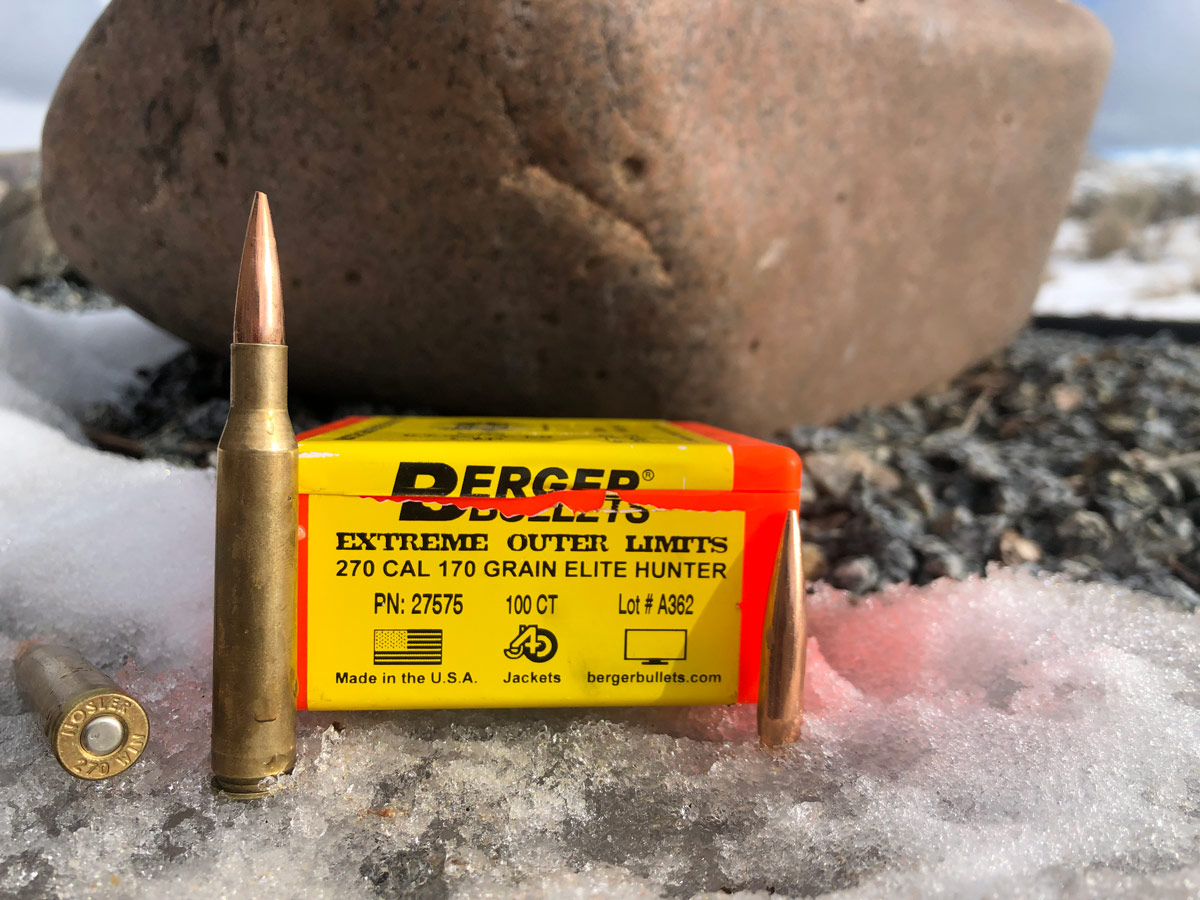
Berger 170 Grain Elite Hunter.
THE BARREL
After I decided on a cartridge and bullet combination, I reached out to my friends over at Preferred Barrel Blanks to see what buttons they had to cut a barrel in the .277 diameter. I was informed they could go as fast as 1:8 (One bullet revolution every 8 inches of the barrel). Berger bullets Recommend a 1:9 twist or faster for the 170 EOL, so I decided to go with the 1:8 to be on the safe side. I have never experienced any problems with over-stabilizing projectiles. I like using Preferred Barrel Blanks because they are quick and produce a good quality barrel. Additionally, they offer many different chamberings, twist rates, contours, and barrel fluting options. They also have shouldered and variable shoulder pre-fits for a variety of actions. For the Howa 1500, I went with a 26" barrel in the taperless .750 counter (lightest contour they could still thread 5/8x24) with a savage nut style variable shoulder. A couple of months later, my barrel arrived, and with headspace gauges, barrel vice, and the correct barrel nut wrench, I was able to have my new barrel on my action in less than 10 minutes.
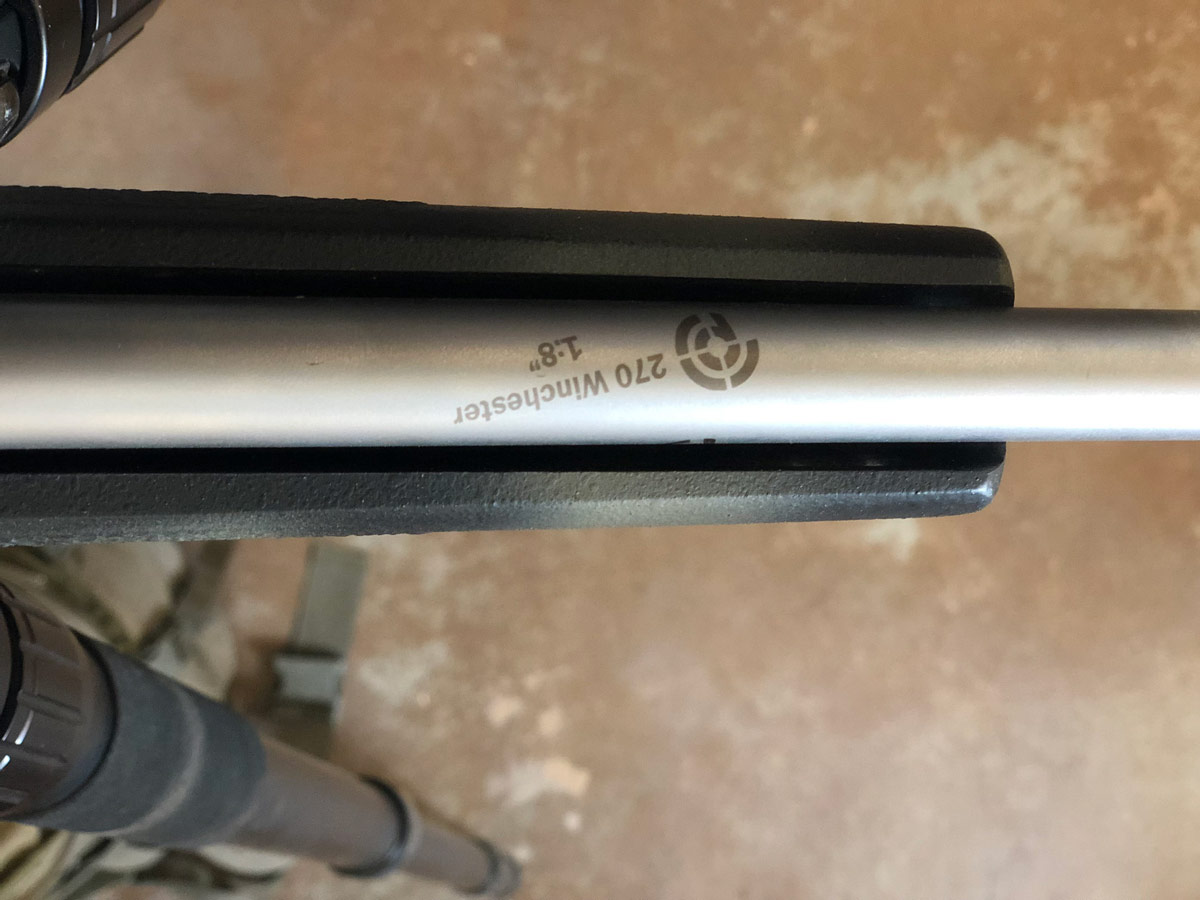
THE LOAD
Two weeks before hunting season, I started load development. At that point, I took the remainder of a 1 pound jug of Reloader 26 and a box of 170 grain EOL projectiles I had on the shelf and loaded up some once fired Nosler brass I had sitting around. My load development consisted of a rough optimal charge weight test and trying a few different seating depths. For my competition loads, I want extreme spreads in the low teens and group sizes at half-inch or better, but for the ranges, I would be shooting during elk season E.S. of under 30, and .75 MOA would be acceptable. I was able to arrive there within my first 50 rounds. I was also happy to find a velocity node around 2850 fps.
THE HUNT
The biggest challenge I have seen when hunting in Colorado is the excessive pressure put on animals from the immense number of hunters. I liked my odds this year because I had drawn a first season tag, which meant I would get a chance to be out there before the animals had been chased around the hills for a few weeks. I also chose an area in the wilderness where motorized vehicles wouldn't be allowed. Most of the hunters we get are relatively out of shape and don't do too well hiking the rugged terrain above 10,000 feet. I had done some E-reconnaissance on Gaia maps and seen a few areas that looked "Elky," so I packed up my Big Agnes Fly Creek UL2 tent and enough food for a few days and hit the trail into the wilderness. I made camp a few hundred yards away from a stream around nightfall. I had my tent nicely nestled under a large evergreen tree. The following day I awoke to fresh snow. This was encouraging as I knew it would allow me to see animal tracks and follow a blood trail more easily.
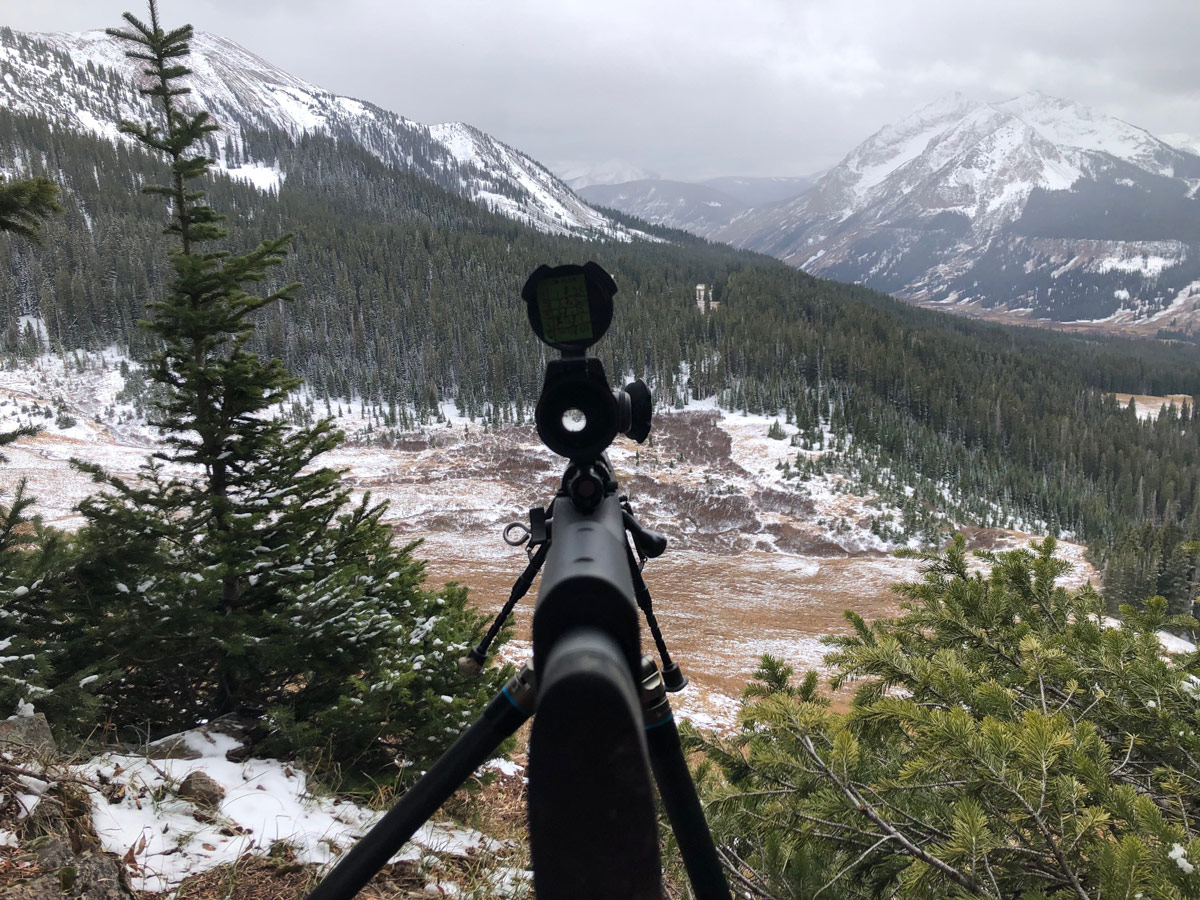
Note the DOPE/Data card in the scope cap.
I donned my insulated poncho, grabbed my tripod, binos, and rifle, and found a good location near my camp. Within 30 minutes of setting up my tripod with my rangefinding binoculars, I spotted a small herd of 8 elk moving sidehill on the opposite slope of the valley I was camping in. My Sig kilo 3000 BDXs told me they were roughly 1025 yards away (A little further than I would like to attempt with a new rifle and load.), but this was an encouraging sign, especially early in the day. I suspected the animals would travel the same route in the evening, so I came up with a hasty plan to follow the game trail until it reached an open area where I could set up an overwatch position and wait for their return. The trail led to just such a location in a large Valley about 1 1/2 miles later. As it was mid-day, I did not believe they would be moving around much, so I decided to hike to a "nearby" Ridgeline at the back of the valley to get a better vantage point of other possible areas to hunt. It is here I should note a phenomenon that occurs in the mountains, a lack of depth perception and scale. Both in Alaska and in Colorado, I have experienced the never-ending mountain. The top looks very close because of the size of the mountain and the objects on it; however, it can be hours away. So, needless to say, after a bit of huffing and puffing, I made it to the ridgeline and was able to see over into the next valley. It was filled with snow, and I did not see any fresh tracks, so I decided my initial location presented the best opportunity.
More: Tips for Cold Weather Shooting
It was still a few hours before dusk, so I set up just inside a small patch of trees on a knoll overlooking the valley. I started in a small warming fire and tried to thaw my fingers and toes. After getting enough dexterity back in my fingers to work the focus knob on my binoculars, I ventured to the edge of my tree patch to establish my overwatch location. I deployed my Field Optics Research Center column tripod and began glassing with my rangefinding Binos. On closer inspection, it was apparent this valley was well-traveled. There were many game trails bisecting the landscape, and I imagined which type of animal was walking which trail and which direction they were headed. It was also very beneficial in reinforcing what I have already learned about animal behavior and their preferences as far as sticking to cover. In the course of this mental exercise of visualizing what my prey would be doing, I spotted something large and brown. Sure enough, it was a mature cow elk standing right at the edge of the trees.
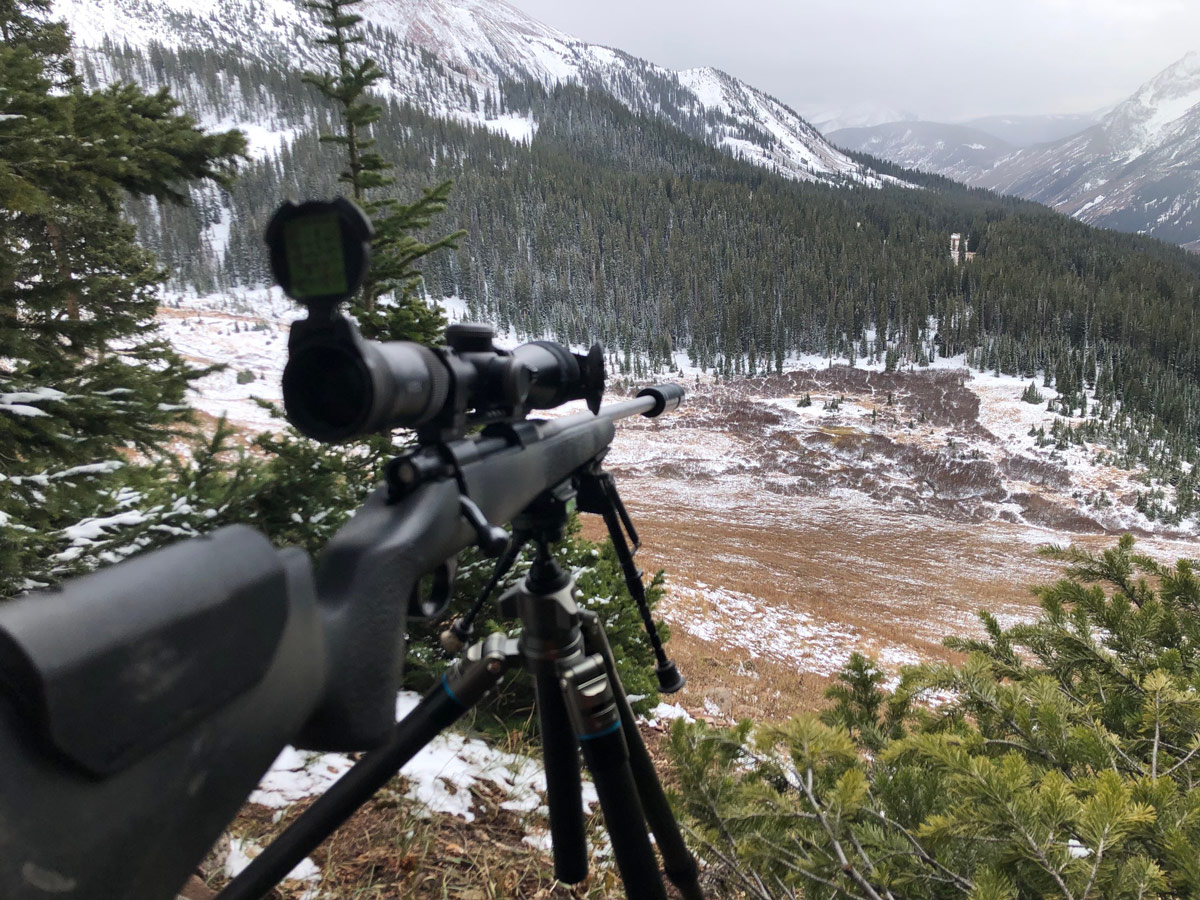
A tripod is an excellent tool for both competition and hunting.
I knew from previous experiences that I may not have much time to set up for this shot, and her body language indicated that she was ready to go down the trail. My rangefinding binoculars, which were mounted on my tripod, displayed a range of 562 yards. I removed the binoculars from my tripod, attached my rifle, which had a small ARCA rail mounted on the bottom, and got ready for a seated angled shot.
Referencing the DOPE card inside my scope cap, I dialed my elevation up nine MOA. One last quick read of the wind told me things were relatively calm, and a two-minute hold would be sufficient to account for the slight crosswind in the valley. I lined up my wind hold on the center of the chest cavity, exhaled, and squeezed the trigger: Bang...wump. The bullet tore through the air faster than the speed of sound, and the sonic boom echoed down the valley. The recoil, combined with the fact the magnification on my scope was set at 15 power (my biggest error), was enough to cause me to lose sight of my target. I returned to the tree I had set as my mental landmark and scanned the area through my rifle scope. Nothing. I had broken a good shot, hadn't I? Yes. Range and dope were good. Hmmm.
I took a deep breath and thought to myself, if I hit her, she'll be bleeding out somewhere right now, and if I didn't, she'd be gone. Either way, it does me no good to come running out of my hide site to see what happened. I went back to my warming fire and had a snack. After about 10 minutes, I figured I needed to satisfy my curiosity. I packed up my gear, put out my fire, and left my hide. As I began to walk down into the valley, I felt a strong breeze on the right side of my face. Had I underestimated the amount of wind between me and my target? I don't think so. I had looked at the falling snowflakes, and the angle they were falling told me the wind was around 5 miles an hour.
I decided I would take a bit of a circuitous route to the point last seen. I made it off of my knoll and down into the valley bottom. It was wetter than I had expected. I hopped the stream running down the center of the valley and made my way to the tree line. As I had suspected, there was a well-traveled game trail inside the trees. I took a right turn and followed the path towards the large tree I had used as my mental landmark when taking the shot.
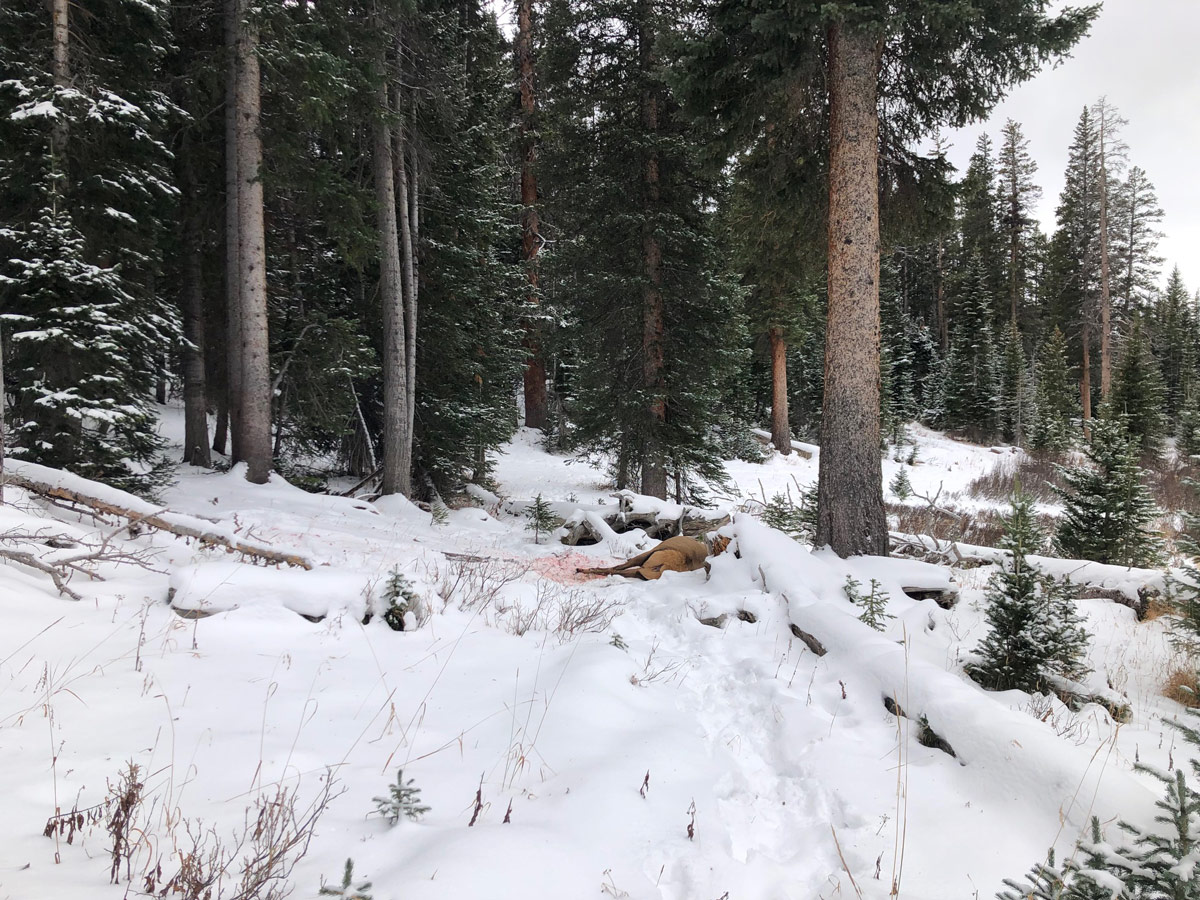
About 20 yards before the tree, something caught my eye. It was a large patch of pink snow. My heart leaped. Pink snow was a good sign; it meant a good shot with lots of oxygen mixed into the blood. A couple of steps further, I saw a large cow elk lying down behind a log. Wow! She was huge! To date, the largest thing I had shot was a black bear. The Sitka Blacktail we hunted in Alaska was small enough to carry, like a backpack or suitcase. This elk was closer to the size of a horse. I thought to myself, "This will be a lot of work." I strained my back, just trying to roll her over as I was skinning her. Two hours and one disposable knife blade later, I had all the hide off and the quarters in bags. It was starting to get dark. I lashed a front and hindquarter to my backpack, buried the rest in snow and stacked logs and sticks over the bags in hopes of keeping carrion off of the meat, and set off for my vehicle.

Colorado.
After arriving home that night, I asked my wonderful wife if she would accompany me the following day to get the remaining quarters and my tent. She was happy for the opportunity to skip work for a day and get some fresh air. We woke up early and made our way out to the trailhead. With a bit of hustle, we covered the 3 miles in, broke down, retrieved my camp and the remaining quarters, and got home in time to meet our kids getting off the bus. I must express my gratitude for having a wife capable of doing events like the Sniper Adventure Challenge. Ashley Hom is a tough individual who can pack well above her weight class.
More: Some Thoughts on Long-Range Hunting
CLOSING
The next two days consisted of slicing steaks and roasts off the bone, making medallions from backstraps, and putting scraps through the KitchenAid meat grinder, some combined with peppered bacon every day seasoning to create a delicious breakfast sausage. Few things are more satisfying than knowing you are feeding your family and sharing the fruits of your labor with friends. It was gratifying to share some Colorado elk with my friends in Alaska, which I got to do when I took a wintertime trip up to Juneau to look for Sitka Blacktail, but that is a story for another day.


 CAD
CAD
 Euro
Euro
